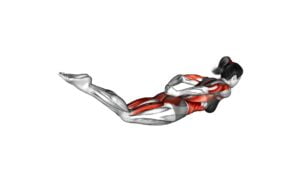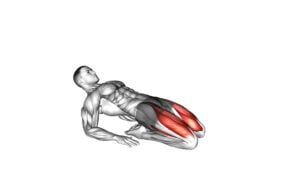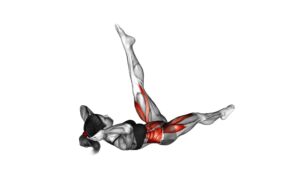Double Leg Stretch (female) – Video Exercise Guide & Tips

Get ready to tone your legs and strengthen your core with the Double Leg Stretch exercise.
Watch This Exercise Video
In this video exercise guide, we'll show you the proper form and technique to maximize your results.
Whether you're a beginner or have limited flexibility, we've got modifications to help you tailor the exercise to your needs.
Avoid common mistakes and discover tips for incorporating Double Leg Stretch into your workout routine.
Let's get started!
Key Takeaways
- Double Leg Stretch targets core muscles and improves stability and posture.
- It works the hip flexors and hamstrings, enhancing lower body strength and flexibility.
- Double Leg Stretch provides stability and prevents injury to the spine and lower back.
- Proper form and technique, along with gradual progression, are important for maximizing effectiveness and preventing strain or injury.
Benefits of Double Leg Stretch
You will experience numerous benefits from incorporating the Double Leg Stretch into your exercise routine. This Pilates exercise targets your core, helping to strengthen and tone your abdominal muscles. By engaging your deep core muscles, you'll improve your overall stability and posture. The Double Leg Stretch also works your hip flexors and hamstrings, enhancing your lower body strength and flexibility.
One of the key benefits of the Double Leg Stretch is its ability to improve your balance and coordination. As you extend your legs away from your body and then bring them back in, you're challenging your body's ability to maintain control and stability. This exercise also promotes body awareness and control, as you must focus on your breath and engage your muscles throughout the movement.
Additionally, the Double Leg Stretch can be modified to suit your fitness level and needs. If you're a beginner, you can start by bending your knees slightly and focusing on the movement of your legs. As you progress, you can gradually straighten your legs and increase the challenge. You can also modify the exercise by using props such as resistance bands or Pilates balls to add resistance or support.
Incorporating the Double Leg Stretch into your exercise routine won't only strengthen and tone your core, but also improve your balance, coordination, and body awareness. With its adaptability, this exercise can be modified to meet your fitness level and goals.
Equipment Needed for Double Leg Stretch
To perform the Double Leg Stretch, you'll need some essential equipment. A yoga mat or comfortable exercise mat is recommended to provide cushioning and support for your body.
Additionally, a small Pilates ball or a folded towel can be used to add resistance and challenge to the exercise.
If you don't have access to these items, there are alternative options you can explore, such as using a carpeted floor or improvising with household items like a pillow or a rolled-up blanket.
Essential Equipment for Double Leg Stretch
To perform the Double Leg Stretch exercise, you'll need a mat and a stability ball. These are essential pieces of equipment that will help you effectively engage your core and improve your overall strength and flexibility.
While there are various equipment options available, a mat and stability ball are the most commonly used and cost-effective alternatives. A mat provides a comfortable and stable surface for you to lie on and perform the exercise, while a stability ball adds an element of instability, challenging your core muscles even more.
The stability ball also allows for a greater range of motion, making the exercise more dynamic and engaging. Investing in these basic pieces of equipment will help you maximize the benefits of the Double Leg Stretch exercise.
Alternatives to Expensive Equipment
Investing in basic pieces of equipment such as a mat and stability ball will help you find alternatives to expensive equipment needed for the Double Leg Stretch exercise. Here are some affordable options and DIY alternatives to consider:
- Yoga strap: Use a long belt or a towel to help with stretching and maintaining proper form during the exercise.
- Pilates ring: Instead of a costly Pilates ring, you can use a resistance band or a small exercise ball to add resistance and challenge to the exercise.
- Pilates ball: If you don't have a stability ball, you can use a rolled-up towel or a small pillow to provide support for your lower back during the exercise.
By utilizing these affordable options and DIY alternatives, you can still perform the Double Leg Stretch effectively without breaking the bank.
Now, let's move on to the next section, where we'll discuss the proper form and technique for the Double Leg Stretch.
Proper Form and Technique for Double Leg Stretch
To perform the Double Leg Stretch with proper form and technique, it's crucial to engage your core throughout the exercise. This means actively pulling your belly button towards your spine and maintaining a stable and controlled position.
Additionally, focus on your breath control, exhaling as you extend your legs and inhaling as you bring them back in. These two key points will help you maximize the effectiveness of the Double Leg Stretch and prevent any unnecessary strain or injury.
Core Engagement Importance
When performing the Double Leg Stretch exercise, it's crucial that you engage your core for proper form and technique. Engaging your core during this exercise is essential for the following reasons:
- Stability: By activating your core muscles, you create a stable foundation for your body, allowing you to maintain balance and control throughout the movement.
- Power: A strong core helps generate power and strength in your limbs, enabling you to execute the exercise with more control and precision.
- Injury prevention: Engaging your core helps protect your spine and lower back from excessive strain, reducing the risk of injury during the exercise.
Engaging your core not only improves your performance in the Double Leg Stretch but also provides numerous benefits for your overall fitness. Make sure to focus on core engagement during this exercise to maximize its effectiveness and minimize the risk of injury.
Breath Control During Exercise
During the Double Leg Stretch exercise, focus on controlling your breath. Proper breath control is essential for maximizing the benefits of this exercise. By using specific breathing techniques, you can enhance your performance and engage your core more effectively.
As you inhale, imagine filling your lungs with air and expanding your ribcage. Exhale deeply, drawing your navel towards your spine and engaging your deep abdominal muscles. This breath control helps to stabilize your core, allowing you to maintain proper form and technique throughout the exercise.
Additionally, controlled breathing promotes relaxation and reduces tension in the body, allowing you to perform the Double Leg Stretch with ease and efficiency. Incorporating breath control into your exercise routine can greatly enhance your overall workout experience.
Modifications for Beginners or Those With Limited Flexibility
For beginners or those with limited flexibility, modifications can be made by using props such as a yoga block or a towel. These modifications allow you to still perform the Double Leg Stretch exercise effectively while accommodating your flexibility limitations.
Here are three modifications that you can try:
- Elevate your head: If you find it challenging to lift your head off the ground during the exercise, you can place a yoga block or a folded towel under your head for support. This will help maintain proper alignment and reduce strain on your neck.
- Bend your knees: If you struggle to straighten your legs fully, you can bend your knees slightly during the exercise. This modification will make it easier to engage your core and extend your legs without compromising your form.
- Use a towel as a strap: If your flexibility prevents you from comfortably reaching your ankles, you can loop a towel around your feet and hold onto the ends. This will provide you with additional length and leverage to perform the exercise with control and precision.
Common Mistakes to Avoid During Double Leg Stretch
One common mistake to avoid during the Double Leg Stretch is failing to maintain proper alignment of your spine. It's essential to keep your spine in a neutral position throughout the exercise to prevent any strain or injury.
Another common mistake is rushing through the movement without engaging your core muscles properly. Remember to initiate the movement from your core and maintain control throughout. Avoid using momentum to swing your legs up, as this can compromise the effectiveness of the exercise. Instead, focus on using your abdominal muscles to lift and lower your legs.
Lastly, be mindful of your breathing. Many people hold their breath during the exercise, which can lead to tension and decreased stability. Remember to inhale as you extend your legs and exhale as you bring them back in.
Tips for Incorporating Double Leg Stretch Into Your Workout Routine
To incorporate Double Leg Stretch into your workout routine, focus on maintaining proper form and engaging your core muscles throughout the exercise. This Pilates exercise is a great way to strengthen your core, improve flexibility, and enhance overall body control.
Here are some tips to help you incorporate Double Leg Stretch effectively:
- Start by lying on your back with your knees bent and feet flat on the floor. Maintain a neutral spine and engage your core muscles.
- As you extend your legs, keep your lower back pressed into the mat and avoid arching it.
- Coordinate your breath with the movement. Exhale as you extend your legs and reach your arms overhead, and inhale as you bring your legs back in and circle your arms around.
By incorporating Pilates exercises like Double Leg Stretch into your workout routine, you can target your core muscles and improve your overall strength and flexibility. Remember to listen to your body, start with modifications if needed, and gradually increase the intensity and difficulty of the exercise as you get stronger.
Don't forget to try different variations of Double Leg Stretch to keep challenging your muscles and avoid plateaus in your fitness journey.
Frequently Asked Questions
How Many Repetitions and Sets of Double Leg Stretch Should I Do?
To determine the number of repetitions and sets for double leg stretch, consider your fitness level and goals. Start with 2-3 sets of 8-12 repetitions and gradually increase as you build strength and endurance.
Modify the exercise by bending your knees if needed, or challenge yourself by adding ankle weights.
Remember to maintain proper form and listen to your body's limits to avoid injury.
Can Double Leg Stretch Help With Improving Flexibility in the Hips?
Double leg stretch is an effective exercise for improving hip flexibility. By incorporating this exercise into your routine, you can reap the benefits of increased range of motion and improved mobility in your hips.
This movement targets the hip flexors and stretches them, helping to loosen up tight muscles and improve overall flexibility. Adding double leg stretch to your workouts can be a great way to enhance your hip flexibility and achieve better results.
Are There Any Variations or Progressions of Double Leg Stretch That I Can Try?
There are several variations and progressions of Double Leg Stretch that you can try to challenge yourself and your core.
By incorporating modifications like adding a resistance band or using a stability ball, you can intensify the exercise and target different muscle groups.
These progressions can help you improve your strength, balance, and overall fitness level.
Don't be afraid to experiment and find the variation that works best for you.
Is Double Leg Stretch Suitable for Individuals With Lower Back Pain?
If you have lower back pain, it's important to find exercises that are suitable for you. Double leg stretch may not be the best option, as it can put strain on your lower back. Instead, try alternative exercises that focus on core strengthening without putting pressure on your back.
Some options include modified versions of the plank, bird dog, or pelvic tilts. Remember to consult with a healthcare professional before starting any new exercise routine.
Can Double Leg Stretch Be Included in a Pilates or Yoga Routine?
Including double leg stretch in your Pilates or yoga routine can have numerous benefits for your core strength. This exercise targets the abdominal muscles, lower back, and hips, helping to improve stability and posture.
Beginners can modify the exercise by bending the knees or keeping the feet on the ground. It's important to listen to your body and only perform movements that are comfortable and within your range of motion.
Consult with a certified instructor for proper guidance.
Conclusion
Incorporating the double leg stretch exercise into your workout routine can bring numerous benefits, such as improved core strength, flexibility, and posture.
It requires no equipment and can be modified for beginners or those with limited flexibility.
By maintaining proper form and avoiding common mistakes, you can maximize the effectiveness of this exercise.
Add the double leg stretch to your fitness regimen and experience the positive impact it can have on your overall fitness and well-being.

Author
Years ago, the spark of my life’s passion ignited in my mind the moment I stepped into the local gym for the first time. The inaugural bead of perspiration, the initial endeavor, the very first surge of endorphins, and a sense of pride that washed over me post-workout marked the beginning of my deep-seated interest in strength sports, fitness, and sports nutrition. This very curiosity blossomed rapidly into a profound fascination, propelling me to earn a Master’s degree in Physical Education from the Academy of Physical Education in Krakow, followed by a Sports Manager diploma from the Jagiellonian University. My journey of growth led me to gain more specialized qualifications, such as being a certified personal trainer with a focus on sports dietetics, a lifeguard, and an instructor for wellness and corrective gymnastics. Theoretical knowledge paired seamlessly with practical experience, reinforcing my belief that the transformation of individuals under my guidance was also a reflection of my personal growth. This belief holds true even today. Each day, I strive to push the boundaries and explore new realms. These realms gently elevate me to greater heights. The unique combination of passion for my field and the continuous quest for growth fuels my drive to break new ground.







